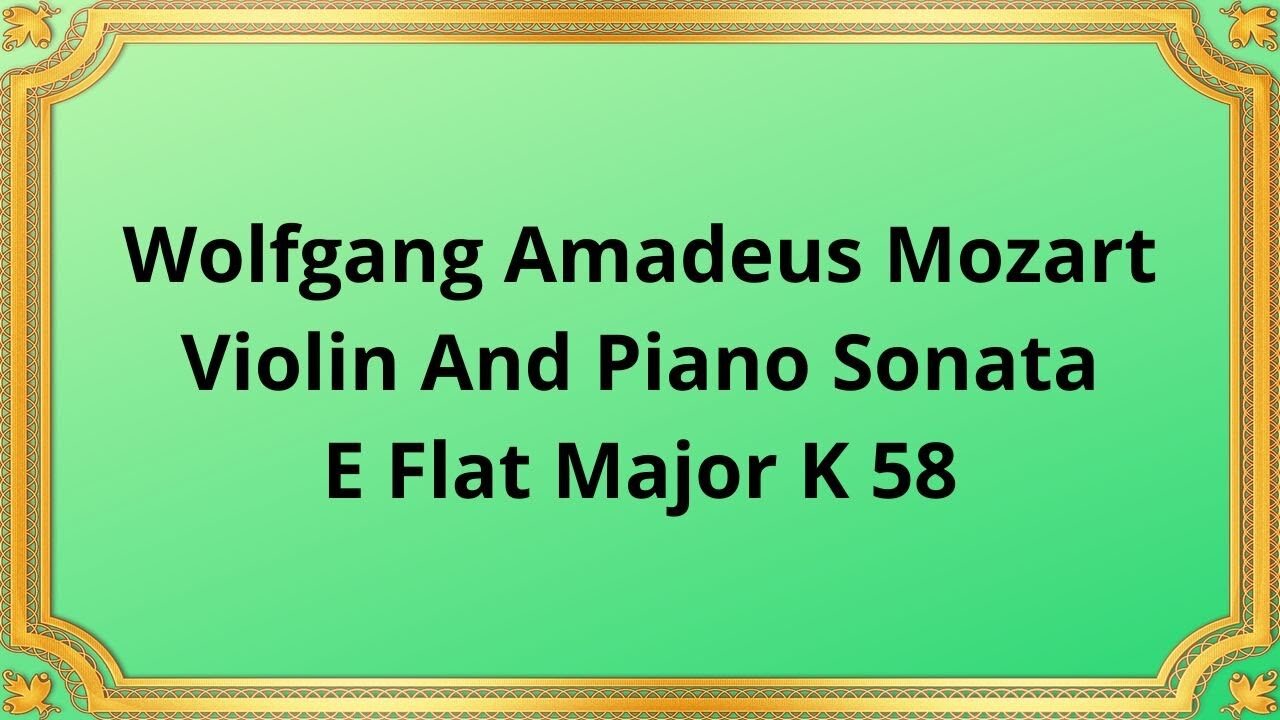Premium Only Content

Wolfgang Amadeus Mozart Violin And Piano Sonata, E Flat Major K 58
#Mozart#Chamber_music#Classical_music#Sonata#Musical_composition
Publication date 1952
Walter Barylli; Paul Badura-Skoda
Wolfgang Amadeus Mozart's Violin and Piano Sonata in E Flat Major, K. 58 is a beautiful and elegant work of chamber music. Written in 1765 when Mozart was just 9 years old, the piece showcases the young composer's prodigious talent and provides a glimpse into the musical style of the late 18th century. In this article, we will explore the history, structure, and musical characteristics of this delightful sonata.
The Violin and Piano Sonata in E Flat Major, K. 58 was composed during a time when Mozart was still a child prodigy. He had already begun composing music at the age of 5, and by the time he was 9, he had already written a number of works for various instruments. The sonata was likely composed as a way to showcase Mozart's talents as a pianist and violinist, and to demonstrate his ability to write sophisticated and elegant music.
The Violin and Piano Sonata in E Flat Major, K. 58 is a three-movement work that follows the standard structure of the classical sonata. The first movement is a lively and playful Allegro, with a memorable and catchy melody that is passed back and forth between the violin and piano. The second movement is a slow and expressive Adagio, which provides a beautiful contrast to the energetic first movement. The third movement is a lively and joyful Presto, which brings the sonata to a triumphant close.
One of the most striking characteristics of the Violin and Piano Sonata in E Flat Major, K. 58 is its elegance and charm. The melodies are light and graceful, with a sense of playfulness and joy that is typical of Mozart's early works. The sonata also features Mozart's signature use of chromaticism, which adds richness and depth to the harmonic language.
Another hallmark of this sonata is its technical demands. While the piece may seem simple and straightforward, it is actually quite difficult to play well. The violin part in particular requires a high level of technical skill and precision from the performer, with fast runs and complex fingerings.
Conclusion
Wolfgang Amadeus Mozart's Violin and Piano Sonata in E Flat Major, K. 58 is a charming and delightful work of chamber music that showcases the young composer's prodigious talent. With its elegant melodies, technical demands, and playful spirit, it remains a favorite of performers and audiences alike.
-
 41:38
41:38
Classical music_Music Inspiration
1 month agoNikolai Andreevich Rimsky Korsakov Symphonic Suite “Scheherazade”
1461 -
 11:21
11:21
Anthony Rogers
3 hours agoKILLSWITCH ENGAGE interview
51 -
 4:31:00
4:31:00
RalliedLIVE
1 day ago $5.95 earnedBattlefield 6 REVEAL w/ Ral
51.7K5 -
 2:11:14
2:11:14
Redacted News
4 hours agoArrest Hillary Clinton!?! Here we go! | Redacted News Live
163K72 -
 1:18:29
1:18:29
Sarah Westall
3 hours ago“This Conversation Would Land Me in Prison in Ireland” - Its the Global Plan w/ Captain Kieran Kelly
31.5K5 -
 44:45
44:45
The White House
4 hours agoPresident Trump Signs an Executive Order, July 31, 2025
33.9K37 -
 1:00:00
1:00:00
BEK TV
21 hours agoOpen Range
1.19K -
 1:15:42
1:15:42
vivafrei
5 hours agoPelosi Doth Protest Too Much! "Trans" Athlete Plot to Harm Female? Crooked hillary Cooked & MORE
113K37 -
 1:42:17
1:42:17
The Quartering
6 hours agoHillary Clinton FINALLY BUSTED, Nancy Pelosi MELTDOWN, Kamala Harris Admits Defeat & More
145K101 -
 3:10:42
3:10:42
Barry Cunningham
11 hours agoMUST SEE: KAROLINE LEAVITT HOSTS WHITE HOUSE PRESS CONFERENCE ( AND MORE NEWS)
78.7K38